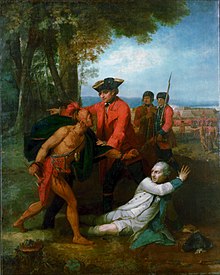Battle of Lake George
| date | September 8, 1755 |
|---|---|
| place | Lake George (now USA ) |
| output | British victory |
| Parties to the conflict | |
|---|---|
|
|
|
| Commander | |
|
Sir William Johnson |
|
| Troop strength | |
| about 1500 | about 1500 |
| losses | |
|
262 |
228 |
The Battle of Lake George between the British and French took place on September 8, 1755 during the French and Indian War ( Seven Years War ) (1754–1763) on Lake George in the US state of New York and ended with a victory for the British.
prehistory
After an open outbreak of hostilities in North America in 1754, the British sent several expeditions against the French in 1755. A British advance on Fort Duquesne (present-day Pittsburgh , Pennsylvania ) failed after the crushing defeat in the Battle of Monongahela on July 9th . Secret documents captured here revealed to the French that the British were planning a second foray into the region of Lake Saint Sacrement ( Lake George ) and the French fort at Crown Point on Lake Champlain . Thereupon French troops were called back, which had the order to attack the British Fort Oswego on Lake Ontario and sent under the German general Ludwig August von Dieskau with 3500 men against the British.
The approximately 1,500 militiamen from the colonies under Sir William Johnson had initially established Fort Lyman (later Fort Edward ) on the Hudson River and on August 28, 1755 reached the Saint Sacrement Lake. Johnson named the lake after King George II. In Lake George has to offer. Dieskau learned about the location and strength of the British from prisoners. He left some of his troops in Fort Ticonderoga and marched with 220 regular soldiers, about 680 Canadian militias and about 600 Indians against Fort Lyman in order to cut off the British supplies by capturing it, but gave up this project in view of the strong occupation and decided an attack on Johnson's main army on Lake George. Johnson learned of Dieskau's presence and sent 1,000 soldiers under Colonel Ephraim Williams and 200 Indians under the Mohawk War Chief King Hendrick against the French.
Course of the battle

Dieskau, for his part, was informed by scouts of the British approach and on the morning of September 8, 1755, he prepared a trap on the road from Lake George to Fort Lyman near the lake.
He posted his regular soldiers in combat formation on the road and the Canadians and Indians on either side between trees and undergrowth. This created a horseshoe-shaped battle line-up with which the British could be taken under fire from three sides. Dieskau's tactics may have been based on the battle of the Monongahela, where a similar line-up had been successfully used by the French's Indian allies. His calculation almost worked. The British had not expected the presence of the French, who they suspected to be near Fort Lyman, and unsuspectingly marched into the trap. Although they were warned by an early shot (allegedly by an Iroquois who wanted to warn his related Mohawks), they were caught in a heavy crossfire and suffered heavy losses.
According to Dieskau, their battle formation collapsed “like a house of cards”. Colonel Williams was shot in the head and King Hendrick was also killed. After a moment of panicked escape, however, some of the troops were regrouped and an orderly retreat towards Lake George was carried out.
The rest of Sir William Johnson, alarmed by the noise of the battle, hastily built barricades out of wagons, boats and tree trunks. The remnants of Williams' division managed to retreat behind this cover. Dieskau carried out several attacks on the British position with the regular soldiers, but they were repulsed by heavy defensive fire supported by several artillery pieces. Indians and Canadians took part in this battle only half-heartedly and withdrew into the woods.
After a losing battle, the French attack collapsed. Dieskau himself was badly wounded and Johnson was shot in the leg. In the afternoon the British counter-attacked, took Dieskau prisoner and forced the French to flee to Fort Frontenac . A detachment of Canadians and Indians was intercepted near the lake and destroyed by 300 militiamen from New York and New Hampshire who had been sent to reinforce them from the south.
consequences
According to official figures, the losses on both sides were largely the same: the British lost 262 dead, wounded and missing, the French, according to their own statements, 228, and according to Johnson allegedly 500–600 men. With the Battle of Lake George, the British had for the first time won a clear victory against the French in this war in America and limited the consequences of the defeat at Monongahela. The victory lost value, however, because Johnson gave up the attack on Crown Point and limited himself to securing the position he had gained by building Fort William Henry on the scene of the battle at the southern end of the lake. Johnson's army suffered from increasing demoralization due to the poor food situation, poor housing and the weather, most of them returned home in November and disbanded.
Web links
- Battle of Lake George (English)
